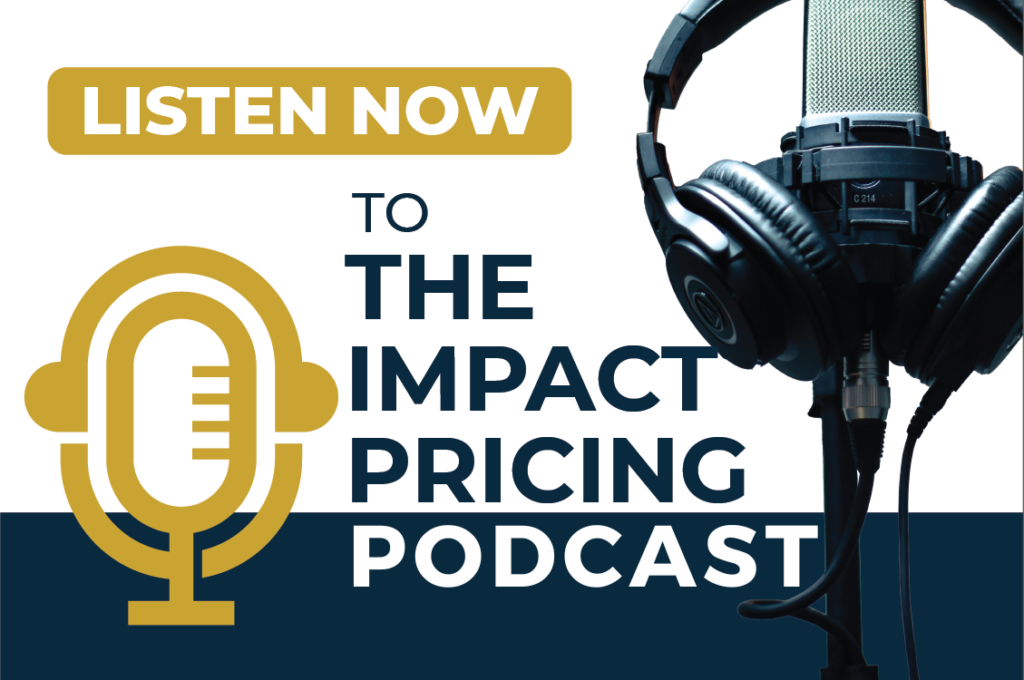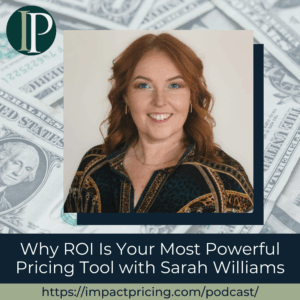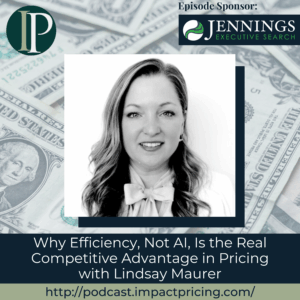Tim J. Smith is the Founder and CEO of Wiglaf, a dynamic and growing advisory firm, where thought leaders in pricing, marketing, sales, and business strategy help firms achieve improved pricing and help executives manage price better.
Tim is also an adjunct professor at DePaul University where he is an Economics and Marketing Professor specializing in Pricing Strategy. He authors books, Pricing Strategy and Pricing Done Right.
In today’s episode, Tim shares the pervasiveness of pricing in a company. He stressed a point on how each key role in the company should have knowledge about pricing concepts to come up with a team effort on value capture.
Podcast: Play in new window | Download
Why you have to check out today’s podcast:
- Discover why value capture is the most important business idea your business should know about
- Find-out where should the pricing function reside in your business?
- Learn why your pricing strategy should be a team effort
“Don’t go for the cheapest customer. Go for your best customer and set your price there.”
– Tim J. Smith
Get Accelerate Your Subscription Business: Your Blueprint to Packaging & Pricing for Growth Course
at https://www.championsofvalue.com
Topics Covered:
01:28 – What paved the way for him into Pricing
02:36 – Why did he name his company Wiglaf
04:04 – What’s the big thing about Pricing today
04:50 – Getting deeper into Pricing being a verb piece
06:32 – Pricing being a team effort
08:59 – Who is a Pricing Person
09:58 – A product manager role in pricing
13:13 – What should really be expected of Pricing people
15:26 – What does it mean when you say “pricing should get involve”
17:20 – Pricing is not a person, it is a verb
18:38 – His company’s, Wiglaf, big projects
21:53 – Some more problems and concerns in Pricing and clients today
22:51 – His valuable Pricing advice that would have a big impact in business
Key Takeaways:
“Don’t go for the cheapest customer. Go for your best customer and set your price there.” – Tim J. Smith
“I do want to point out that I did mean HR because I see pricing also having a role in structuring sales incentives and other incentives about value capture and value communication.” – Tim J. Smith
“ Putting the plan to study, adjusting the Deming constantly, and constant improvement cycle, putting these into your commercial policy and your pricing enables you to make this continual improvement in value capture.” – Tim J. Smith
“Salespeople need tools to communicate value. If you’re going to expect those salespeople to capture any, people also need to know what segments of the market is likely to purchase so that they don’t waste the time on customers that are out of the market.” – Tim J. Smith
Links and Resources Mentioned:
Connect with Tim J. Smith
Connect with Mark Stiving
Full Interview Transcript
(Note: This transcript was created using Temi, an AI transcription service. Please forgive any transcription or grammatical errors. We probably sounded better in real life.)
“It’s an activity. It’s something that companies really need to manage and treat it like it’s a verb. They need to treat pricing as a verb just as they treat manufacturing or sales or something of that nature, and that is changing the way in which companies should organize themselves and make decisions. When it comes to pricing, it’s no longer at the job of an Excel data jockey. It’s an executive decision-making problem.” – Tim Smith
[Intro]
Mark Stiving: Welcome to Impact Pricing, the podcast where we discuss pricing, value, and the incredible relationship between them. I’m Mark Stiving. Today, our guest is the one and only Tim Smith. Here are three things you should know about Tim before we start. He has been CEO of Wiglaf pricing since 2002. That is 17 years for those of you who are having trouble with math. He’s an adjunct professor at DePaul University and he has written four books on pricing, including what I would consider the most comprehensive textbook available today called Pricing Strategy. Welcome, Tim.
Tim Smith: Oh, it’s my honor, Mark.
Mark Stiving: Hey, it’s going to be fun. So how’d you got into pricing?
Tim Smith: Well, I started out saying I did quantitative marketing and I quickly learned that that meant nothing to anybody but I landed a job with Symantec and they were addressing a pricing question because Microsoft decided to try to enter the antivirus area and Symantec liked an article I wrote about how Symantec should respond. My basic response to Symantec was to ignore Microsoft. They’re a small player, you’re charging good money. I know they’re cheaper than you, but they haven’t taken your space. And I made more money in that project than I usually did in two years of work. And I decided, huh, I think pricing should be the focus of what quantitative marketing means.
Mark Stiving: So you’re telling me that you made more money by saying don’t do anything.
Tim Smith: Yeah.
Mark Stiving: Okay, nice. Love that. So when you did that project with Symantec, is that when you formed Wiglaf?
Tim Smith: No, I had already had Wiglaff formed back in 2002 as you mentioned, but I didn’t focus solely upon pricing until about 2007.
Mark Stiving: Oh, okay. So, Wiglaf was the quantitative marketing piece in the beginning. Nice. Okay. Where does Wiglaf come from? What’s the name mean?
Tim Smith: Wiglaf was Beowulf’s advisor and just like a good advisor, the very first Anglo Saxon advisor, he handed Beowulf the sword to kill Grendel’s mother. He didn’t kill Grendel’s mother. As a good consultant. My job is to enable my Beowulf executives to go out there and slay their dragons, make good decisions.
Mark Stiving: What a great answer. I take it. You’ve practiced that one a few times.
Tim Smith: Well, I thought it was a good name for a business. You know, the very first recorded Anglo Saxon consultant advisor. I have since realized that very few people remember Beowulf or have read Beowulf and it was just too obscure, but I still liked the name.
Mark Stiving: Yeah. And it’s fun to tell the story, so who cares?
Tim Smith: I’m certainly not going to name my company. Smith and associates.
Mark Stiving: That’s a good, good thing. Good thing. So what prompted you to form the company in the first place?
Tim Smith: Oh, I was unemployed. I had been looking for work for about a year. Had no luck. People kept saying, well you should go on and consulting. We like what you’re saying. So I listened to them and then I had to learn the difference between a compliment and a customer.
Mark Stiving: That sounds painful.
Tim Smith: It was, but I’m out of that pain today. So it’s fine.
Mark Stiving: Yeah, things are going well for you. I can tell. So let’s talk about pricing cause that’s what people really want to hear about. And what’s a big question I could ask? What do you think is the most important thing to know about pricing today?
Tim Smith: It’s an activity. It’s something that companies really need to manage and treat it like it’s a verb. They need to treat pricing as a verb just as they treat manufacturing or sales or something of that nature. And that is changing the way at which companies should organize themselves and make decisions when it comes to pricing, it’s no longer the job of an Excel data jockey. It’s an executive decision-making problem.
Mark Stiving: That’s an interesting concept by the way. I really liked the book Pricing Done Right. So, I really enjoyed that book. In the fact that you talked a lot about roles and responsibilities in there and who needs to do what. Is that leading you to the pricing as a verb piece?
Tim Smith: Oh, definitely. It was based upon that research where I, I wrote an article about that topic or that pricing’s the verb. What had happened is when I started in pricing, the first question I had was, well, let’s define the field. What is pricing as a field, and that’s what led to the textbook you mentioned Pricing Strategy. I realized listening to a lot of talking people at conferences, they didn’t really define the subject. They just kind of talked around it. We didn’t really have the right tools, tools, and techniques and thought paradigms for making pricing of a profession within a company. Well when pricing strategy was written, it’s a great book if you want to learn how to do pricing. I as a pricing person. Awesome. The problem is is that I don’t expect the CEO to read the tools and techniques and all of the intricacies of pricing. I want a CEO, she, to organize her team to make pricing done. Right. And that was the nature of the second book. The research.
Mark Stiving: Yeah. You know, one of the things I struggle with a lot is I tell people I’m a pricing expert and so often people reply, Oh, I don’t do pricing. But that is so far from the truth because so many people touch, how do we create value? How do we communicate value? How do we capture value? It’s, it’s pervasive in the company. And so how do you get a company to, I don’t know, what’s the word? Is it pricing? Is it value? How do you get a company to adopt this concept that says, look, it’s a, it’s a team effort. It’s not a person.
Tim Smith: I think you’ve hit upon a very large problem and it’s one that is hard work to try to convert companies away from that viewpoint. You take like a large food manufacturer, food producer, think of breakfast cereals. For instance, in the breakfast cereal market, uh, marketing may come up with a target price they handed over to sales that are given some sort of budget for managing allocations and they assume that they have pricing under control. I don’t know if a single cereal manufacturer that’s making good money, clearly there’s something wrong, but to get the word out to that group, to the CEO, it’s just a challenge. You take a look at the best metrics that were the best metrics I’ve seen came out of BCG on the number of pricing people per company and they said that half billion-dollar company should have about five because there’s just nothing you could do with less than five.
There’s a core number, but outside of that, there should be one pricing person for 200 million in revenue. Now consider one pricing person professional within a company per 200 million in revenue. How many salespeople do you have per 200 million in revenue? Probably a hundred. So we have a one to 100 ratio of salespeople to pricing people. How many marketing communications people do you have or the budget that goes to marketing communications and your role as marketing communications is going to take a much larger budget. So when we’re looking at pricing and its importance, it’s just glossed over because people are focused too much on salespeople in sales management, our marketing communications, and marketing management, and they miss the entire value equation.
Mark Stiving: So, I struggle with that a little bit in that, when you say the word pricing person, I think of two very different types of people. One I would think of as a, let’s, let’s use the word pricing analyst for now and they’re managing the price book, they’re dealing with price changes. It’s, it’s more of the tactical work. And then I would think of a strategic pricing manager who should be coaching people inside the company, coming up with pricing strategies, implementing pricing systems that we’re going to use. And so when you say a person or when BCG does, which one are they referring to or is it both?
Tim Smith: I believe from the article that I read, it appeared to me that they were thinking about the whole pricing team. I’m going to use the John Hackett approach. He talked about the pricing thought leader in a company than the pricing manager in the company and then the pricing analysts in the company as being the whole pricing team and yeah, it’s just a small number and for all long too often I’d actually call what you called a pricing analyst, just a pricing administrator. They weren’t considered actual decision-makers, they were just administering pricing.
Mark Stiving: Yeah. Somebody else was doing the thinking behind it and saying, here, now we need to go implement this. Go, go make this happen. So, huh. Okay. And so pick another role. Let’s talk about a product manager, someone who’s trying to decide what’s the next version of the product we’re going to go build. That person has to know pricing, if they’re going to do their job well.
Tim Smith: They should understand some aspects of pricing. I’m not going to require them to know all the tools and techniques of pricing. I’m not gonna ask a product manager to understand how to do conjoint analysis or construct economic value to customer spreadsheet or do a proper voice of customer one-on-one interview technique, but I do want them to know how to run those projects or what parts they need to contribute to economic value to customer. Simple technique. It’s been around for maybe 30 years and yet I see one product management team after the other that has never applied it and if you want to understand the value you’re delivering to your customers in the first place, that’s a great starting place. And then from that value, if you want to estimate how much you can capture through price, again, totally excellent. It’s pricing, getting inserted in the new product development cycle or something of that nature, rather than being considered nothing more than an afterthought. And what’s my cost? I’ll just add on my usual margin. It’s changing the way management thinks.
[AYSB Ad] Time out real quick add, if you’re currently working on a subscription business, I’m guessing this is what your world feels like, Oh my gosh, the CEO just said, we need to grow faster. I already have too many things to do now, what are we adding? Which of these things should I be doing? If I only sleep for hours and I come in earlier, I can get more done?
Well, here’s my advice. You can go with the flow and do what you’re told. I mean, doing busy work and doing what other people tell you to do isn’t the worst job in the world. After all, I used to dig ditches for a living or there’s a better alternative. Take responsibility. You determine what drives your product’s growth. When you choose the right activities and then execute them well, it boosts your career.
To help you drive your product’s growth, we put together a powerful online course called Accelerate Your Subscription Business. This course provides you the framework that helps you decide which of your tasks are most important right now. And most importantly, though, it helps us think strategically about your subscription business, not just about your tactics.
The course is only $500. What a tiny investment, considering what this can do for your company and your career.
To learn more, go to www.championsofvalue.com. I look forward to seeing you there.
Mark Stiving: Yeah, I think that’s really fair. I tend to not think pricing people need to do the things you talked about, right? I don’t think pricing people have to know how to run conjointly. I think we have, not you and I, but a pricing person inside a company has to understand what it is and when to use it and how to use it and how to interpret it, but they’re really there to coach the people to say, look, are we thinking about value for the products that we build and as we talk about them in the marketplace, is that consistent or do you think they really need to know those techniques?
Tim Smith: I agree with you completely. You take some companies like 3M where they’re constantly innovating. There, they’ll do an enjoy internal conjoint analysis team. You take a different company that’s manufacturing, let’s say MRI. There’s no, I have no expectations that a Medtronic making an MRI machine would know how to do a conjoint. And if they needed that conjoint on, they would outsource it because it’s just, but they do need to know, should we do conjoint? Should I do economic value to the customer? How would I actually want to analyze my prices once they’re in the market? What does the historical transactional analysis look like? What are the questions I need to address?
Mark Stiving: Yeah. I would think the pricing person would absolutely be on top of all of those KPIs, watching trends, trying to figure out where we have opportunities for improvement. What else does it mean when you say pricing as a verb? What am I missing so far? You gotta be more to it.
Tim Smith: So I want pricing to get deeply engaged in product development with the product managers rather than just being an afterthought after the product has already been developed. I also want pricing to get deeply engaged in sales enablement. Salespeople need tools to communicate the value. If you’re going to expect those salespeople to capture any, people also need to know what segments of the market is likely to purchase so that they don’t waste the time on customers that are out of the market. They’re really out of scope. There are so many ways that pricing can help salespeople structure their deals even at the discount and the tactical decision making levels to drive greater profitability and greater performance for that salesperson. Pricing should get engaged in those decisions as well. The sales enablement, the commercial policy, that discounting strategy.
Mark Stiving: So when you say pricing should get involved, do you mean in your mind are you thinking that pricing person should be involved or are you thinking the people who do this should have a grasp of pricing concepts that they’re using as they do their job?
Tim Smith: I’m going to answer in a slightly different direction. I want a pricing professional to be working probably internally to be working with their sales executive to design the commercial policy with them. Pricing experts are awesome at clarifying trade-offs and detecting where value may set, well, helping that that sales executive understand their trade-offs and then designing the commercial policy according to those trade-offs enables the sales executive to be more effective when they’re out there in the field. That’s one part, the big design. Then there’s the sales enablement part, which can often be done with tools where you actually just make sure the right price goes out to the right customer at the right time, but periodically we need to analyze the decisions being made about commercial policy and say, well, as an afterthought, what are those good decisions? Can we improve them? Putting the plan to study, adjust the Deming constantly? I think so. Deming, constant improvement cycle or Crosby. Yeah, he also has it and then there’s shooting and you know something like the dye Mac or six Sigma, whatever. Putting that into your commercial policy and your pricing enables you to make this continual improvement in value capture.
Mark Stiving: Okay. Tim, I am loving talking to you because you are making my head hurt as I think through this. I think my single biggest disconnect with everything we’re talking about is, I love the concept of pricing is a verb. And I think the disconnect is pricing is not a person in my mind, but I haven’t heard you say that yet.
Tim Smith: Oh, it’s not a person, but I’m talking about it as a verb. I’m acknowledging it’s a problem to be managed just like anything else. And so we need to have people who understand pricing, working with people who are experts and there are other fields, whether it be product development or innovation or sales or even HR.
Mark Stiving: Okay. Now I am 100% with you. That was beautiful.
Tim Smith: I do want to point out that I did mean HR because I see pricing also having a role in structuring sales incentives and other incentives about value capture and value communication.
Mark Stiving: Okay. So I absolutely agree that pricing adds a lot of value in sales compensation plans, right? As we start to think through those. Anything else in HR?
Tim Smith: No, I’ll stop.
Mark Stiving: Okay. So in my mind, I was thinking, well, we want to hire people who understand the value and the concepts. And, but I wasn’t sure I could go there. You can. Okay, so let’s shift gears just a little bit. Tell me about Wiglaf. What are your big projects, the types of things you like to do?
Tim Smith: About three to four times a year we go into a medium-size enterprise, small to medium-size enterprise and we spend a quarter doing a pricing transformation project and in that pricing transformation project we look first at the question of how are you making decisions today? Who’s making them, who’s not making them but should be making them? What is the outcome of those decisions? Is that the outcome you actually expected? Then we start to work on the people and the culture and the culture change is probably the biggest part. How do we change the way a team works so that sales, marketing and finance each brings their A-game to a pricing decision and enable the CEO for her to reach her goals with her business or business unit. That’s been a large part of it. The other part of our pork is new product development. Got to put a price on it. Let’s go right the price on it the first time, other than let you go out the door and say, Hey, we left tons of money on the table.
Mark Stiving: Yeah. Yeah. So those pricing transformation projects sound like a lot of fun. But it also sounds like you need the executive to have said, I get it. We’re not treating pricing as a verb today. We need to transform the entire company.
Tim Smith: I don’t expect the CEO to say all of that on day one, but, they’re saying we have a pricing problem, let’s say if we can’t improve our pricing, but around week five we have, I’m gonna say it to come to Jesus meeting where we got to preach the truth and say, this is what’s happening here. Is this what you want? And by the way, here’s the vision of what you could be running. Do you want to stay where you are or are you ready to make some changes? And it’s in that very difficult meeting and it takes four days where they say, okay, I think I see where the culture change needs to take place. And then the actual culture change itself, it’s going to take another 10 weeks of work to actually drive and implement.
Mark Stiving: Yeah, I would guess it takes way more than that. But you have another 10 weeks of work to do.
Tim Smith: Yeah. After that, you know, initial transformation, then you know there’s stewardship and support meetings and such like this that are ongoing, but I can’t expect an executive team to think about the cost internally of this. A sales executive, a marketing executive or a finance executive and the CEO all engaged in a project for an entire quarter. That’s an extremely expensive cost internally for the team to drive major improvements.
Mark Stiving: Right. I mean the good news is the return is probably guaranteed to be huge.
Tim Smith: Exactly. The return is huge. It’s just work.
Mark Stiving: It is. It is. All right. Hey, so any other big problems you’re seeing in pricing and clients today? That might be interesting.
Tim Smith: I’m getting less and less of this. Let’s just find our costs and mark it up and continually get this. I need to know my competitor’s price so I can price the same price or lower and I get it, but it’s problematic. Then every now and then I’m tripping across this. Let’s just build a huge customer base first. Then we’ll figure out how to do pricing after all that worked for Uber-no, Lyft-no. We Work-no. Amazon, questionably. Yeah, so you still get that kind of weird mindset that says the value of what I’m creating, we don’t need to worry about how to capture it through a price and I’m thinking good luck with that industry.
Mark Stiving: Okay, well we’re going to have to wrap this up here in just a second, but I always end with the following question. What’s one piece of pricing advice that you would give our listeners that you think would have a big impact on their business?
Tim Smith: Don’t go for the cheapest customer. Go for your best customer and set your price there.
Mark Stiving: Nice. Let’s try doing segmentation before we set our prices. Yeah, very nice. Very nice. Hey Tim, thank you so much for your time today. If anyone wants to contact you, how can they do that?
Tim Smith: You talked to me on LinkedIn where 450,000 other people did.
Mark Stiving: All right. Episode 43 all done. My favorite part of today’s podcast, let’s see. I think it’s the whole concept that says pricing is a verb and it’s pervasive across the company. Cause I, I’m just so in agreement with that whole concept. What was your favorite part? Please let us know in the comments or wherever you downloaded and listen to the podcast while you’re at it. Would you give us a five-star review? And if you have any questions or comments about the podcast or about pricing, feel free to email me at [email protected]. Now go make an impact.
**Note: Mark Stiving has an active LinkedIn community, where he participates in conversations and answers questions. Each week, he creates a blog post for the top question. If you have a question, head over to LinkedIn to communicate directly with Mark.
Tags: Accelerate Your Subscription Business, ask a pricing expert, pricing strategy














